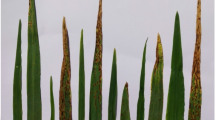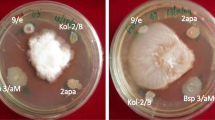Abstract
Bacillus cereus C1L has been demonstrated to induce systemic disease resistance against Botrytis elliptica in lily. The objective of this study was to investigate physiological responses of B. cereus C1L-triggered systemic resistance in lily cv. Star Gazer against B. elliptica. By histological and biochemical analyses, leaves inoculated with B. elliptica displayed cell death, H2O2 accumulation and lignin deposition. As plants were elicited with B. cereus C1L, cell death, H2O2 accumulation and lignin deposition in leaves caused by B. elliptica infection were suppressed, revealing that suppression of oxidative burst might be associated with B. cereus C1L-induced systemic resistance. In reactive oxygen species inhibitors assays, B. elliptica-caused lesion numbers and H2O2 accumulation in lily leaves were significantly reduced as leaves were pretreated with catalase or diphenylene iodonium. Furthermore, the expression of LsGRP1 and LsPsbR in leaves elicited with B. cereus C1L and inoculated with B. elliptica was decreased. The same expression pattern was also observed in leaves pretreated with catalase or diphenylene iodonium and inoculated with B. elliptica. These results suggest that B. cereus C1L-induced systemic resistance may be related to suppression or alleviation of oxidative stress and cell death of lily caused by B. elliptica.








Similar content being viewed by others
Abbreviations
- ROS:
-
reactive oxygen species
- ISR:
-
induced systemic resistance
- CAT:
-
catalase
- DPI:
-
diphenylene iodonium
- dai:
-
days after inoculation
- hpi:
-
hours post inoculation
References
Apel, K., & Hirt, H. (2004). Reactive oxygen species: metabolism, oxidative stress, and signal tranduction. Annual Review of Plant Biology, 55, 373–399.
Asai, S., & Yoshioka, H. (2009). Nitric oxide as a partner of reactive oxygen species participates in disease resistance to necrotrophic pathogen Botrytis cinerea in Nicotiana benthamiana. Molecular Plant-Microbe Interactions, 22, 619–629.
Baker, C. J., & Mock, N. M. (1994). An improved method for monitoring cell death in cell suspension and leaf disc assays using evans blue. Plant Cell, Tissue and Organ Culture, 39, 7–12.
Baker, C. J., & Orlandi, E. W. (1995). Active oxygen in plant pathogenesis. Annual Review of Phytopathology, 33, 299–321.
Blokhina, O., Virolainen, E., & Fagerstedt, K. V. (2003). Antioxidants, oxidative damage and oxygen deprivation stress: a review. Annals of Botany, 91, 179–194.
Compant, S., Duffy, B., Nowak, J., Clément, C., & Barka, E. A. (2005). Use of plant growth-promoting bacteria for biocontrol of plant diseases: principles, mechanisms of action, and future prospects. Applied and Environmental Microbiology, 71, 4951–4959.
Daudi, A., Cheng, Z., O’Brien, J. A., Mammarella, N., Khan, S., Ausubel, F. M., & Bolwell, G. P. (2012). The apoplastic oxidative burst peroxidase in Arabidopsis is a major component of pattern-triggered immunity. The Plant Cell, 24, 275–287.
De Vleesschauwer, D., Cornelis, P., & Höfte, M. (2006). Redox-active pyocyanin secreted by Pseudomonas aeruginosa 7NSK2 triggers systemic resistance to Magnaprothe grisea but enhances Rhizoctonia solani susceptibility in rice. Molecular Plant-Microbe Interactions, 19, 1406–1419.
De Vleesschauwer, D., Chernin, L., & Höfte, M. M. (2009). Differential effectiveness of Serratia plymuthica IC1270-induced systemic resistance against hemibiotrophic and necrotrophic leaf pathogens in rice. BMC Plant Biology, 9, 9.
Doss, R. P., Chastagner, G. A., & Riley, K. L. (1984). Techniques for inoculum production and inoculation of lily leaves with Botrytis elliptica. Plant Disease, 68, 854–856.
Edlich, W., Lorenz, G., Lyr, H., Nega, E., & Pommer, E. H. (1989). New aspects on the infection mechanism of Botrytis cinerea Pers. Netherlands Journal of Plant Pathology, 95, 53–62.
Elad, Y. (1992). The use of antioxidants (free radical scavengers) to control grey mould (Botrytis cinerea) and white mould (Sclerotinia sclerotiorum) in various crops. Plant Pathology, 41, 417–426.
Felix, G., Duran, J. D., Volko, S., & Boller, T. (1999). Plants have a sensitive perception system for the most conserved domain of bacterial flagellin. The Plant Journal, 18, 265–276.
Glazener, J. A. (1982). Accumulation of phenolic compounds in cells and formation of lignin-like polymers in cell walls of young tomato fruits after inoculation with Botrytis cinerea. Physiol. Plant Pathol., 20, 11–25.
Govrin, E. M., & Levine, A. (2000). The hypersensitive response facilitates plant infection by the necrotrophic pathogen Botrytis cinerea. Current Biology, 10, 751–757.
Grace, S. C., & Logan, B. A. (2000). Energy dissipation and radical scavenging by the plant phenylpropanoid pathway. Philosophical Transactions of the Royal Society of London. Series B, Biological Sciences, 355, 1499–1510.
Grant, J. J., & Loake, G. J. (2000). Role of reactive oxygen intermediates and cognate redox signaling in disease resistance. Plant Physiology, 124, 21–29.
Grellet-Bournonville, C. F., Martinez-Zamora, M. G., Castagnaro, A. P., & Diaz-Ricci, J. C. (2012). Temporal accumulation of salicylic acid activates the defense response against Colletotrichum in strawberry. Plant Physiology and Biochemistry, 54, 10–16.
Hou, P. F., & Chen, C. Y. (2003). Early stages of infection of lily leaves by Botrytis elliptica and B. cinerea. Plant Pathol Bull., 12, 103–108.
Hsieh, T. F., Huang, J. W., & Hsiang, T. (2001). Light and scanning electron microscopy studies on the infection of oriental lily leaves by Botrytis elliptica. European Journal of Plant Pathology, 107, 571–581.
Huang, C. J., Wang, T. K., Chung, S. C., & Chen, C. Y. (2005). Identification of an antifungal chitinase from a potential biocontrol agent, Bacillus cereus 28-9. Journal of Biochemistry and Molecular Biology, 38, 82–88.
Hückelhoven, R. (2007). Cell wall-associated mechanisms of disease resistance and susceptibility. Annual Review of Phytopathology, 45, 101–127.
Jana, S., & Choudhuri, M. A. (1982). Glycolate metabolism of three submerged aquatic angiosperms during ageing. Aquatic Botany, 12, 345–354.
Kloepper, J. W., Ryu, C. M., & Zhang, S. (2004). Induced systemic resistance and promotion of plant growth by Bacillus spp. Phytopathology, 94, 1259–1266.
Lamb, C., & Dixon, R. A. (1997). The oxidative burst in plant disease resistance. Annual Review of Plant Physiology and Plant Molecular Biology, 48, 251–275.
Levine, A., Tenhaken, R., Dixon, R., & Lamb, C. (1994). H2O2 from the oxidative burst orchestrates the plant hypersensitive disease resistance response. Cell, 79, 583–593.
Liu, Y. H., Huang, C. J., & Chen, C. Y. (2008a). Evidence of induced systemic resistance against Botrytis elliptica in lily. Phytopathology, 98, 830–836.
Liu, Y. H., Huang, C. J., Yang, K. H., & Chen, C. Y. (2008b). Effect of hydrogen peroxide on infection of lily by Botrytis elliptica. Plant Pathology Bulletin, 17, 307–314.
Liu, Y. H., Huang, C. J., & Chen, C. Y. (2010). Identification and transcriptioncal analysis of genes involved in Bacillus cereus-induced systemic resistance in Lilium. Biologia Plantarum, 54, 697–702.
Lu, Y. Y., & Chen, C. Y. (2005). Molecular analysis of lily leaves in response to salicylic acid effective towards protection against Botrytis elliptica. Plant Science, 169, 1–9.
Lugtenberg, B., & Kamilova, F. (2009). Plant-growth-promoting rhizobacteria. Annual Review of Microbiology, 63, 541–556.
Lugtenberg, B. J. J., Chin-A-Woeng, T. F. C., & Bloemberg, G. V. (2002). Microbe-plant interactions: principles and mechanisms. Antonie Van Leeuwenhoek, 81, 373–383.
Mansfield, J. W., & Hutson, R. A. (1980). Microscopical studies on fungal development and host responses in broad bean and tulip leaves inoculated with five species of Botrytis. Physiol. Plant Pathol., 17, 131–144.
Mehdy, M. C. (1994). Active oxygen species in plant defense against pathogens. Plant Physiology, 105, 467–472.
Mengiste, T., Chen, X., Salmeron, J., & Dietrich, R. (2003). The BOTRYTIS SUSCEPTIBLE1 gene encodes an R2R3MYB transcription factor protein that is required for biotic and abiotic stress responses in Arabidopsis. The Plant Cell, 15, 2551–2565.
O’Brien, T. P., Feder, N., & McCully, M. E. (1964). Polychromatic staining of plant cell walls by toluidine blue O. Protoplasma, 59, 367–373.
Ride, J. P. (1975). Lignification in wounded wheat leaves in response to fungi and its possible role in resistance. Physiol. Plant Pathol., 5, 125–134.
Ryals, J. A., Neuenschwander, U. H., Willits, M. G., Molina, A., Steiner, H. Y., & Hunt, M. D. (1996). Systemic acquired resistance. The Plant Cell, 8, 1809–1819.
Thomma, B. P. H. J., Eggermont, K., Penninckx, I. A. M. A., Mauch-Mani, B., Vogelsang, R., Cammue, B. P. A., & Broekaert, W. F. (1998). Separate jasmonate-dependent and salicylate-dependent defense-response pathways in Arabidopsis are essential for resistance to distinct microbial pathogens. Proceedings of the National Academy of Sciences of the United States of America, 95, 15107–15111.
Thordal-Christensen, H., Zhang, Z., Wei, Y., & Collinge, D. B. (1997). Subcellular localization of H2O2 in plants: H2O2 accumulation in papillae and hypersensitive response during the barley-powdery mildew interaction. The Plant Journal, 11, 1187–1194.
Tiedemann, A. V. (1997). Evidence for a primary role of active oxygen species in induction of host cell death during infection of bean leaves with Botrytis cinerea. Physiological and Molecular Plant Pathology, 50, 151–166.
Torres, M. A., Jones, J. D. G., & Dangl, J. L. (2006). Reactive oxygen species signaling in response to pathogens. Plant Physiology, 141, 373–378.
van Baarlen, P., Staats, M., & van Kan, J. A. L. (2004). Induction of programmed cell death in lily by the fungal pathogen Botrytis elliptica. Molecular Plant Pathology, 5, 559–574.
van Baarlen, P., Woltering, E. J., Staats, M., & van Kan, J. A. L. (2007). Histochemical and genetic analysis of host and non-host interactions of Arabidopsis with three Botrytis species: an important role for cell death control. Molecular Plant Pathology, 8, 41–54.
van Loon, L. C., Bakker, P. A. H. M., & Pieterse, C. M. J. (1998). Systemic resistance induced by rhizosphere bacteria. Annual Review of Phytopathology, 36, 453–483.
van Loon, L. C., Bakker, P. A. H. M., van Der Heijdt, W. H. W., Wendehenne, D., & Pugin, A. (2008). Early responses of tobacco suspension cells to rhizobacterial elicitors of induced systemic resistance. Molecular Plant-Microbe Interactions, 21, 1609–1621.
Varnier, A.-L., Sanchez, L., Vatsa, P., Boudesocque, L., Garcia-Brugger, A., Rabenoelina, F., Sorokin, A., Renault, J.-H., Kauffmann, S., Pugin, A., Clement, C., Baillieul, F., & Dorey, S. (2009). Bacterial rhamnolipids are novel MAMPs conferring resistance to Botrytis cinerea in grapevine. Plant, Cell & Environment, 32, 178–193.
Verhagen, B. W. M., van Loon, L. C., & Pieterse, C. M. J. (2006). Induced disease resistance signaling in plants. In J. A. Teixeira da Silva (Ed.), Floriculture, ornamental and plant biotechnology (Vol. III, pp. 334–343). UK: Global Science Books Ltd.
Verhagen, B. W. M., Trotel-Aziz, P., Couderchet, M., Höfte, M., & Aziz, A. (2010). Pseudomonas spp.-induced systemic resistance to Botrytis cinerea is associated with induction and priming of defence responses in grapevine. Journal of Experimental Botany, 61, 249–260.
Wojtaszek, P. (1997). Oxidative burst: an early plant response to pathogen infection. Biochemical Journal, 322, 681–692.
Yang, H., Zhao, X., Wu, J., Hu, M., & Xia, S. (2011). The benefits of exogenous NO: enhancing Arabidopsis to resist Botrytis cinerea. American Journal of Plant Sciences, 2, 511–519.
Acknowledgements
This study was supported by the National Science Council grants 96-2317-B-002-001 and 97-2317-B-002-001 to C. Y. Chen and by the Aim for Top University Project of National Taiwan University grants 99R40044 and 10R40044 to C. J. Huang.
Author information
Authors and Affiliations
Corresponding author
Additional information
Chien-Jui Huang and Yi-Hung Liu contributed equally.
Rights and permissions
About this article
Cite this article
Huang, CJ., Liu, YH., Yang, KH. et al. Physiological response of Bacillus cereus C1L-induced systemic resistance in lily against Botrytis leaf blight. Eur J Plant Pathol 134, 1–12 (2012). https://doi.org/10.1007/s10658-012-0013-6
Accepted:
Published:
Issue Date:
DOI: https://doi.org/10.1007/s10658-012-0013-6




